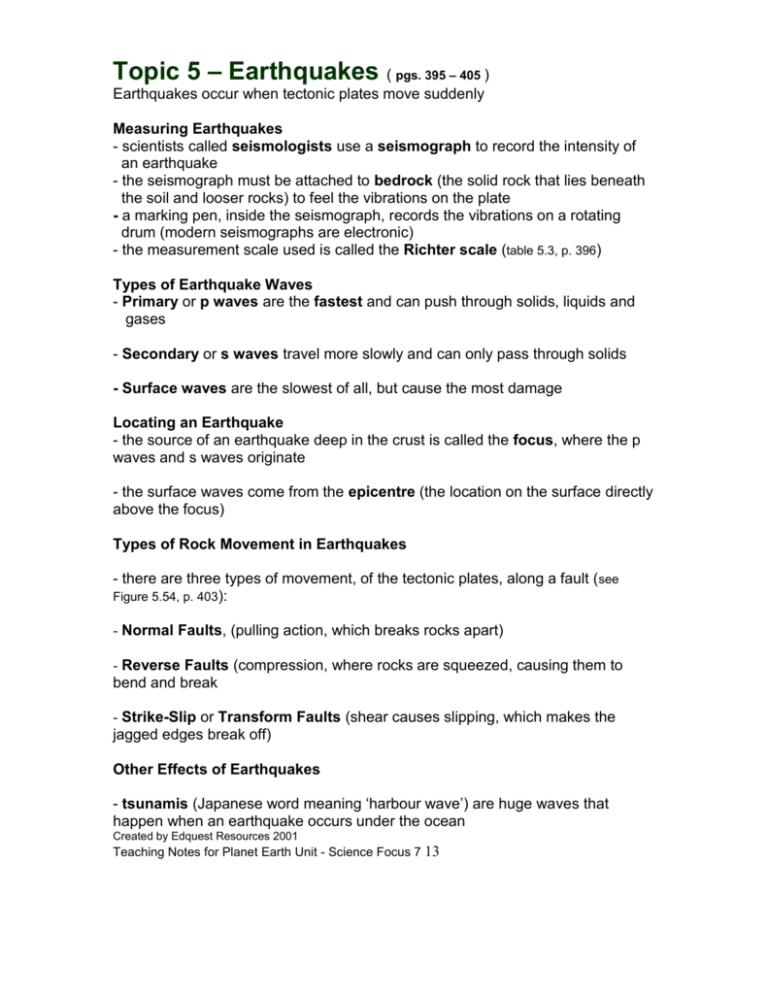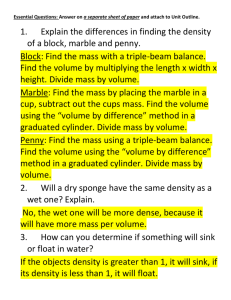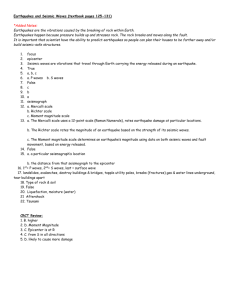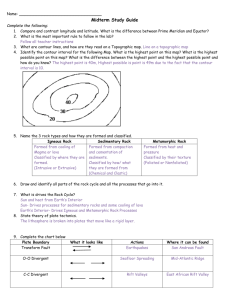File
advertisement

Topic 5 – Earthquakes ( pgs. 395 – 405 ) Earthquakes occur when tectonic plates move suddenly Measuring Earthquakes - scientists called seismologists use a seismograph to record the intensity of an earthquake - the seismograph must be attached to bedrock (the solid rock that lies beneath the soil and looser rocks) to feel the vibrations on the plate - a marking pen, inside the seismograph, records the vibrations on a rotating drum (modern seismographs are electronic) - the measurement scale used is called the Richter scale (table 5.3, p. 396) Types of Earthquake Waves - Primary or p waves are the fastest and can push through solids, liquids and gases - Secondary or s waves travel more slowly and can only pass through solids - Surface waves are the slowest of all, but cause the most damage Locating an Earthquake - the source of an earthquake deep in the crust is called the focus, where the p waves and s waves originate - the surface waves come from the epicentre (the location on the surface directly above the focus) Types of Rock Movement in Earthquakes - there are three types of movement, of the tectonic plates, along a fault ( see Figure 5.54, p. 403): - Normal Faults, (pulling action, which breaks rocks apart) - Reverse Faults (compression, where rocks are squeezed, causing them to bend and break - Strike-Slip or Transform Faults (shear causes slipping, which makes the jagged edges break off) Other Effects of Earthquakes - tsunamis (Japanese word meaning ‘harbour wave’) are huge waves that happen when an earthquake occurs under the ocean Created by Edquest Resources 2001 Teaching Notes for Planet Earth Unit - Science Focus 7 13 Topic 6 – Volcanoes ( pgs. 406 – 411 ) -A volcano is an opening in the Earth’s crust that releases lava, steam and ash when it erupts (becomes active). -The openings are called vents. -When volcanoes are not active, they are called dormant. -Volcanoes that form a circle around the Pacific Ocean are called the Ring of Fire (derived from the circle of volcanoes that pour out red hot lava, fire and steam) Topic 7 – Mountains ( pgs. 412 – 417 ) Mountain Formation and Distribution - most mountains are large areas that have uplifted due to the movement (converging, diverging or sliding) or heating of tectonic plates, where the build up of heat and pressure can cause folding and faulting - sedimentary rock under slow, gradual pressure can fold (bend like plastic because they are made soft by the heat) or break – and can be changed to metamorphic rock in the process - the upward, or top part of folded rock is called anticline, the bottom is called syncline - rock that is too brittle to fold under heat and pressure, will break, called thrust faulting Ages of Mountains - mountains that are jagged at the top are ‘young’ mountains, while those that are more rounded (due to erosion and weathering) are ‘old‘ mountains Topic 8 – Fossils ( pgs. 418 – 422 ) Fossils are preserved impressions in rock that tell us when, where, and how living organisms lived and behaved millions of years ago. Types of Fossils Remains of dead plants and animals that have been protected from scavengers can become fossilized in a number of ways: - petrified (rock-like) fossils preserve the bones of dead animals by using silica - an outline or impression from the carbon residue on rock surfaces can provide a carbonaceous film - original remains may be preserved in tar, amber or peat bogs - trace fossils are evidence of animal activity, like worm holes, footprints, and burrows Topic 9 – Geologic Time ( pgs. 423 – 427 ) The principle of superposition states that in undisturbed layers of rock, the oldest layers are always on the bottom and the youngest layers are always on the top. As new layers of sediment form sedimentary rock, the layers can be identified. This layering is called strata. Relative Dating Geologists use a technique called relative dating, to find the order in which events occurred. The relative age of the rock is determined by its position within the strata. Fossils found in a layer can help to identify the age of the rock. RadiometricDating - By measuring the amounts of change in a sample, scientist can clculate the absolute age of the rock. This is called Radiometric Dating - Scientists also use a process called radiocarbon dating (which uses carbon14, a rare form of carbon, as its parent material) - All organisms take in carbon-14 to build cells and tissue. The carbon-14 changes to nitrogen gas (when the animal dies) in a half-life of 5730 years. The amount of carbon-14 left in the tissue allows scientists to determine the age of the remains Topic 10 – Fossil Fuels ( pgs. 428 – 432 ) Petroleum is a naturally occurring mixture of hydrocarbons, such as bitumen, coal, oil and gas. It is found in sedimentary rock basins, which were formed from the sediments of tiny plants and animals deposited in the mud and silt. The soft parts of these organisms were transformed into solid, liquid or gas hydrocarbons called fossil fuels. (Coal is usually formed from plants that grew on the land, oil from water-based plants and animals and natural gas from landbased or water-based plants and animals) - Bitumen is a heavy, almost solid form of petroleum. Some deposits can be mined (because they are close to the surface – like, in the Athabasca Tar Sands - There are three ways that oil and gas can be trapped (see Figure 5.91, p. 429): � A … thrust fault � B … normal fault � C … reef







